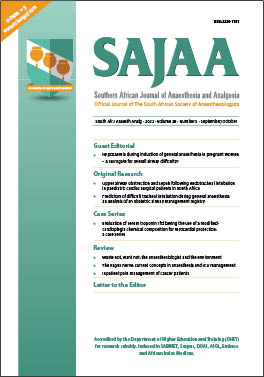Predictors of difficult tracheal intubation during general anaesthesia: an analysis of an obstetric airway management registry
Keywords:
caesarean delivery, general anaesthesia, hypoxaemia, obstetric anaesthesia, airway managementAbstract
Background: Complications during airway management can be life-threatening. This study aimed to identify anatomical and physiological risk factors for hypoxaemia during tracheal intubation in obstetric general anaesthesia (GA).
Methods: A retrospective analysis was performed of data from an obstetric airway management registry (ObAMR) on tracheal intubation during GA in patients with a gestational age from 20 weeks, and until 7 days post-delivery. The primary outcome was arterial desaturation to < 90% during airway management. Logistic regression was performed to identify associations with hypoxaemia.
Results: Data were collected for 1 095 general anaesthetics in the ObAMR. Overall, 143/1 091 of patients (13.1%, 95% CI 11.1–15.4%) experienced arterial oxygen desaturation. Univariate analysis showed that 91/142 (64.1%) of patients who desaturated were obese (body mass index [BMI] > 30 kg/m2), compared with 347/915 (37.9%) who were obese and did not experience desaturation (p < 0.001). A receiver operating characteristic curve was constructed post hoc, which showed a cut-off point for BMI of 29.76 kg/m2, with a sensitivity of 0.66 and specificity of 0.62 for predicting hypoxaemia. Desaturation occurred in 17.0% of patients with hypertensive disorders of pregnancy, versus 11.0% without the condition (p = 0.005). Increasing Mallampati class was associated with an increased incidence of hypoxaemia. The incidence of hypoxaemia was 25.8% when intubation was performed by interns, compared with 8.0% for specialist anaesthetists (p = 0.005). In the multivariate analysis of factors associated with hypoxaemia, BMI (p < 0.001), room air saturation prior to preoxygenation (p = 0.008), and airway oedema (p = 0.027) were independently associated with hypoxaemia.
Conclusion: In this study, hypoxaemia was used as a composite indicator of anatomical and physiological difficulty. Using this concept, a predictive tool could be developed to identify a difficult airway in obstetrics. Further research is required to show whether simple interventions such as face mask ventilation and the use of high-flow nasal oxygenation during intubation reduce the incidence of life-threatening hypoxaemia.
Downloads
Published
Issue
Section
License
By submitting manuscripts to SAJAA, authors of original articles are assigning copyright to the SA Society of Anaesthesiologists. Authors may use their own work after publication without written permission, provided they acknowledge the original source. Individuals and academic institutions may freely copy and distribute articles published in SAJAA for educational and research purposes without obtaining permission.
The work is licensed under a Creative Commons Attribution-Non-Commercial Works 4.0 South Africa License. The SAJAA does not hold itself responsible for statements made by the authors.

